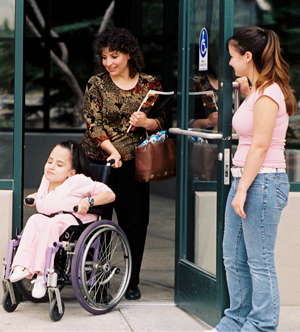
Government Health Care Assistance Programs for People
Who Have Inadequate or No Medical Coverage

“It may not seem possible at first, but it is important to start saving money. It makes life a lot easier, a lot smoother, and a lot freer. And there are goals, like higher education or opportunities within the community, that are not automatically covered by government programs.”
—Deborah Leuchovius, parent advocate, mother of Frederick
Government-provided health care assistance programs offer health care to a variety of groups of people:
- Families who have children with disabilities and special health care needs
- Low-to middle-income families who:
- Do not have employer-provided health care
- Cannot afford private health care
- Cannot afford the co-payments
Government health care assistance programs such as Medicaid provide coverage for these groups of people.
Types of Health Care Assistance Programs
Exploring government health care assistance options can be a daunting task. States and local governments run these programs, often under a variety of names and departments. And program eligibility requirements and health care services differ from state-to-state as well.
If you are just beginning to find out about government health care assistance programs, contact your county’s Office of Public Assistance or Social Services. A case worker will describe what programs are available, and the eligibility requirements and health care services offered for each one.
Children and Youth with Special Health Care Needs (CYSHCN)
Families of children with disabilities who don’t qualify for Medicaid and have little or no health insurance can obtain the following health care assistance through Children and Youth with Special Health Care Needs (CYSHCN) programs:
- Health insurance
- Income
- Health and medical care
CYSHCN program eligibility is usually based on the child’s age and health condition, the family’s income, and place of residence. “Special needs” refers to serious and long lasting conditions such as these types of disabilities:
- Physical
- Intellectual
- Developmental
- Behavioral
- Emotional
Examples of CYSHCN Program Services (each state’s program will be different)
- Assistive technology
- Case management
- Early intervention and screening for health risks
- Family support services
- Immunization
- Nutrition counseling
- Special education support services
- Translation
- Transportation
To get more information about your state’s CYSHCN program:
Call your state’s Department of Public Health & Human Services, or your county’s Office of Public Assistance or Social Services. Each state or county may assign a unique name to its CYSHCN program.
Also contact the Family-to-Family Health Information Center in your state:
Family Voices, Inc
Call 1-888.835-5669
Visit www.FamilyVoices.org and click “State FV” to find the family center in your state
Write
P.O. Box 37188
Albuquerque, NM 87176
Children’s Health Insurance Program (CHIP)
This program, formerly known as State Children’s Health Insurance Program (SCHIP), is designed to provide health insurance to children of families who cannot afford private insurance but whose incomes are modest enough that it exceeds Medicaid’s income limitations. The Children's Health Insurance Reauthorization Act of 2009 authorized additional funding to help make CHIP available to more families.
CHIP’s Minimum Level of Medical Services Offered
Each state’s program differs, but all must offer at least these services:
- Routine check-ups
- Immunizations
- Dental and vision care
- Inpatient and outpatient hospital care
- Laboratory and X-ray services
To get more information about your state’s CHIP:
Call your state’s Department of Public Health & Human Services or your county’s Office of Public Assistance or Social Services.
Visit http://finder.healthcare.gov to locate your local office.
Speak with the nurse at your child’s school; in some states, you can apply for CHIP benefits through the public school system.
Medicaid

Medicaid is a federal program run by the states that covers the cost of some medical care for millions of low-income families and people with disabilities. It is the foundation of the CYSHCN and CHIP health care assistance programs. An important role Medicaid plays is in providing medical services to people with disabilities that many health care plans are typically not designed to provide.
Who Qualifies for Medicaid
To become eligible for Medicaid, individuals must meet two conditions based on:
- Income, usually tied to the Federal Poverty Level (FPL), which in 2010 was $22,050 per year for a family of four (see Kaiser Commission on Medicaid and the Uninsured. Medicaid: A Primer 2010. The Henry J. Kaiser Family Foundation. June 2010. Page 7).
- Category type, such as pregnant women, children, and individuals with disabilities.
Children under six years of age are eligible for Medicaid if their families’ income, as of 2010, is under $29,326.50 (133 percent of FPL). Children from six through 18 years of age qualify if their families’ income is below the FPL. Again, that level in 2010 is $22,050 per year for a family of four.
The 2010 Health Care Reform Act will broaden Medicaid eligibility to anyone under age 65 whose income is under $29,326.50 (133 percent of FPL) at some time during the first five years of the Act. This broadened eligibility will remove the “category type” condition explained above, thereby basing Medicaid eligibility solely on income.
Each state may apply its own Medicaid eligibility requirements that are less strict than the federal standards. For example, a state may allow families with higher incomes to participate in its Medicaid program by paying a monthly premium or co-payment (see Kaiser Commission on Medicaid and the Uninsured. Medicaid: A Primer 2010. The Henry J. Kaiser Family Foundation. June 2010. Page 17). Speak with your local Medicaid office for information on your state’s Medicaid programs.
Medicaid and Supplemental Security Income (SSI)
Many children enter the Medicaid system through the Supplemental Security Income Program. Each state sets its own eligibility requirements based on income level and types of assets owned. In most states, children receiving SSI automatically qualify for Medicaid, yet enrollment into Medicaid is not always automatic. Check with your county’s Office of Public Assistance or Social Services for Medicaid enrollment information.
What Medicaid Covers
Medicaid covers a diverse range of conditions that many health care plans, such as an employer-paid plan, have typically not covered. In addition to providing traditional medical care, such as doctor’s visits, Medicaid also covers:
- Inpatient and outpatient hospital services
- Dental and vision care; depends on the state—fewer states are offering this type of coverage
- Laboratory and x-ray services
- Early screening
- Transportation and translation services
- Long-term care; includes home- and community-based services (HCBS) and acute (emergency room) care
Each state has the option of providing additional health care services, such as personal care, prescription drugs, and rehabilitation services.
How to Locate Your Local Medicaid Office
Call either your state’s Department of Health and Human Services or your county’s Office of Public Assistance or Social Services to find out how to contact your local Medicaid office. You may also visit www.HealthCare.gov to find your local office online.
Medicaid Options
Through the provisions of the Deficit Reduction Act (DRA) of 2005, states acquired greater flexibility in qualifying individuals for Medicaid and offering expanded levels of medical services. For example, states may offer optional health care assistance programs that have less restrictive income requirements. The difference in these optional programs is that, unlike Medicaid, individuals may have to go on a waiting list to receive health care service, and the services themselves may be limited.
Buy-In to Medicaid
Through the Family Opportunity Act (FOA) Medicaid Program, families with incomes, as of 2010, up to $66,150 for a family of four (300 percent of Federal Poverty Level) are eligible to purchase Medicaid coverage for their children with disabilities through monthly Medicaid premiums. A child may be covered by private medical insurance and still be covered by the FOA Medicaid Program.
Medicaid Waivers
States can request waivers from federal Medicaid regulations. This means states can expand Medicaid coverage by covering more people and expanding the level of services offered. Presently, waivers allow states to cover “optional” groups that include (see Kaiser Commission on Medicaid and the Uninsured. Medicaid: A Primer 2010. The Henry J. Kaiser Family Foundation. June 2010. Page 9):
- Working individuals with disabilities earning up to, as of 2010, $$55,125 (250 percent of Federal Poverty Level).
- Individuals who receive home- and community-based (HCBS) services.
- Individuals who live in nursing homes with incomes up to 300 percent of SSI requirements (each state sets its own SSI income limits).
- The “medically needy” who don’t meet federal low-income requirements but spend a high proportion of their income on medical expenses.
Home- and Community-Based Services (HCBS)
Since the mid-twentieth century, people with severe disabilities obtained long-term care in nursing home facilities, sometimes located far from the individual’s home and supportive network of professionals, friends, and family. In 1999, the Olmstead decision, a Supreme Court ruling, determined that the practice of only providing health care and other supports to individuals with disabilities in nursing home facilities (as opposed to in their own home, apartment or other community setting) was in violation of the Americans with Disabilities Act (ADA). Today, states are increasingly providing supports for HCBS services, a trend that helps individuals with disabilities live independently and greatly improve the quality of their lives.
2010 Health Care Reform update: Some states are offering the HCBS Medicaid state plan option called Community First Choice Option. Through this option, states would not have to limit eligibility or the amount of services provided. This option is being offered to people with disabilities who have incomes, as of 2010, up to $33,075 (150 percent of the Federal Poverty Level; see The Henry J. Kaiser Family Foundation. “Focus on Healthcare Reform.” June 2010).
How to Find Home- and Community- Based Services (HCBS) Near You
Contact your county’s Office of Public Assistance or Social Services, or your county case manager to find what HCBS are offered in your area. It is important to remember that the provision of these services through Medicaid is a fairly recent trend. Not all communities may offer HCBS.
Tax Equity and Fiscal Responsibility Act of 1982 (TEFRA) State Plan Option
When a child receives extended care in an institutional setting, family income is disregarded as a qualification for Medicaid. The TEFRA State Plan Option makes it possible to do the same for a family whose child requires care at the level provided in an institution, but who choose to care for their child at home. (see Catalyst Center. “TEFRA & TEFRA Look-alike Programs.” Retrieved from http://www.hdwg.org/catalyst/cover-more-kids/tefra on November 12, 2010).
Not all states offer the TEFRA state plan option. Contact your state’s Department of Public Health & Human Services or your county’s Office of Public Assistance or Social Services to find out if your state offers this Medicaid state plan option.
Money Follows the Person
This is an incentive program for states to move people with disabilities from nursing home facilities into home- and community-based services.
2010 Health Care Reform update: States received more funding to facilitate transferring individuals with disabilities from nursing home facilities to home- and community-based services. The eligibility requirement that a person be in a nursing home for six months has been reduced to 90 days.
Medicare

This government program is available to children with certain disabilities and to dependent adult children whose parents are currently receiving Medicare.
Who qualifies for Medicare:
- Children with amyotrophic lateral sclerosis (ALS or Lou Gehrig’s disease) and end-stage renal disease (ESRD or kidney failure) can qualify for Medicare coverage soon after they have been determined to have a permanent disability.
- Dependent adult children who developed a permanent and severe disability before the age of 22 and whose parents currently receive Medicare are eligible to also receive Medicare benefits. A two-year waiting period for these benefits begins when the child turns 18 years of age. If the parent receiving Medicare benefits dies, the child will continue to receive benefits.
To get more information on Medicare eligibility and benefits, contact Medicare:
Call 1-800-633-4227
Visit www.medicare.gov
If You Do Not Qualify for Health Care Assistance And Cannot Afford Insurance
Perhaps you are unable to meet the eligibility requirements for government health care assistance programs. You find the monthly cost of private insurance too expensive, but you want it and need it. A possible solution is to consider ways to create financial capacity to pay the insurance premiums.
As an option, speak with a financial professional or counselor to find out how you might modify your life style or increase your income to afford monthly insurance payments. Also, take a look at the money management tools presented in Managing Your Finances, such as creating a spending plan and tracking how you spend your money.
Non-Medical Benefits
Two federal benefit programs provide non-medical assistance income to children and young adults with disabilities: Supplemental Security Income (SSI) and Social Security Disability Insurance (SSDI).
Determining your child’s eligibility for SSI and SSDI and applying for benefits can be lengthy processes. You will be asked many questions about your child’s disability, which you will have to support with medical records and written statements from teachers and others who have known your child over a period of time.
For a more detailed presentation on who is eligible and how to apply for benefits for each of these programs, contact the Social Security Administration:
Call 1-800-772-1213 (Voice) or 1-800-325-0778 (TTY). Ask for the contact information of your local office.
Visit www.ssa.gov/ssi or www.ssa.gov/disability .
Supplemental Security Income (SSI)
This federal program provides people with disabilities who have little or no income with cash assistance for basic needs such as food and shelter. Eligibility for SSI can begin at birth and last until 18 years of age (or, if a student, until the age of 22). Eligibility is also based on:
- Financial need
- The Social Security Administration’s definition of “disability for children”
To continue coverage beyond 18 years of age, your child must meet the Social Security Administration’s requirements for need and definition of “disability for adults.” Individuals who receive SSI may not have more than $2,000 in assets such as cash, investments, vehicles, and personal property. Some states have stricter asset requirements, meaning individuals may own less than $2,000 in assets.
Anyone who qualifies for SSI automatically qualifies for Medicaid; however, Medicaid enrollment is not automatic in all states. Check with your county’s Office of Public Assistance or Social Services for information on SSI enrollment.
Social Security Disability Insurance (SSDI)
This federal program provides income to people with disabilities who are unable to work. Your child may be eligible if your child:
- Is over the age of 18 and:
- You, the parents, have paid into the Social Security System though payroll taxes
- Your child meets the Social Security Administration’s “definition of disability”
- Your child’s disability occurred before the age of 22
- Paid into the Social Security System through payroll taxes
The SSDI benefit amount is based on the length of the work period, either yours or your child’s, and the total amount of income earned.
State Mandated Insurance Programs
As part of the 2010 Health Care Reform, states are now able to offer subsidized premiums to individuals previously denied insurance because of pre-existing conditions. These programs are called high-risk insurance pools. As of this publication’s writing, states are in the process of ramping up on this program, which will be offered until 2014 (National Conference of State Legislatures,. "Coverage of Uninsurable Pre-existing Conditions: State and Federal High-Risk Pools" November 5, 2010.) Individuals are responsible for paying part of the monthly premium.
For more information on the high-risk insurance pool offered in your state, visit www.StateHealthFacts.org and search on “high risk pool eligibility."
"You learn a lot over the years. Back when my daughter was first diagnosed, I thought we should pay for everything because we could. I thought ‘programs’ were for truly needy people. I simply had no idea of the costs we would incur. I wish we had applied for programs we were eligible for in the very beginning.”
—Carol Bakies, mother of Sarah
The Issue of Medical Privacy — The Health Insurance Portability and
Accountability Act (HIPAA) of 1996
What prompted the passage of this federal Act were situations where people were using patient medical records in ways that had nothing to do with their health care. For a hypothetical example, consider a banker who has access to the medical records of his customers. The banker looks for customers with serious health conditions assuming they wouldn’t be able to pay off the mortgage, and forecloses on their homes. That used to be legal. Now it is not, thanks to the HIPAA Act.
Imagine all the people who have access to your child’s medical information—people such as claims processors, visiting doctors, people studying in medical and health care programs. HIPAA provides patients and employees who have health care plans with several privacy protections. Health care providers that must comply to HIPAA:
- Hospitals and clinics
- Nursing homes
- Home health agencies
- Most physicians, pharmacists, and dentists
- Ambulance services
- Managed care organizations
- Some local health and social services departments
- Laboratories
- State Medicaid programs
Key Provisions
Access to Your Medical Records
At any time you can request to see your medical records, which must be sent to you within 30 days of the date you request them. You might have to pay for copying and postage costs.
Notice of Privacy Practices
You must be informed on how your health and medical information will be used. You’ll typically receive a notice of this information the first time you visit or use one of the health care providers listed above, and be requested to read and sign the notice.
Limits on How Your Health and Medical Information is Used
The health care providers listed above need certain information to provide you with the best possible care. However, your information may not be used in ways unrelated to your health care (like the example given in the introduction to this section). This means that if you share your personal information with a health care provider, it must first get your permission before sharing that information with marketers and advertisers.
Stronger State Laws
States may apply greater protective measures than what the federal HIPAA law requires.
Requests for Confidentiality
You may request that individuals of the health care providers listed above keep confidential any communications you have with them: verbal, electronic, written, or typed. Those individuals must take reasonable steps to meet your request for confidentiality.
Complaints
You may file a formal complaint if you think your or your child’s health and medical information is being used in ways unrelated to health care.
How to File a Complaint
You may file a complaint through the U.S. Department of Health and Human Services or your regional Office of Civil Rights (OCR).
The U.S. Department of Health and Human Services
Call 1-877-696-6775 (ask for your regional Office of Civil Rights (OCR) office)
Visit www.hhs.gov and click “Regulations”
Write
200 Independence Avenue, S.W.
Washington, D.C. 20201
Privacy and Your Child’s School Health Records

The Family Educational Rights and Privacy Act (FERPA) of 1974 is designed to protect students’ educational records, which include their health records. This protection applies to students attending federally funded (public) schools, kindergarten through senior year of high school. Until students turns 18, parents have the right to inspect and modify their children’s educational records, and control (with some exceptions) how those records are released to other individuals. After the age of 18, those rights transfer to students who attend any federally funded educational intuition, such as public colleges and universities (see U.S. Department of Education. “Family Educational Rights and Privacy Act (FERPA).” Retrieved from http://www2.ed.gov/policy/gen
/guid/fpco/ferpa/index.html on November 14, 2010).
For more information on FERPA, visit www.ed.gov and search on “Family Educational Rights and Privacy Act (FERPA).”
Next Chapter: Life and Disability Insurance
